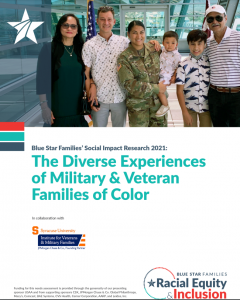In collaboration with the Institute for Veterans and Military Families
This comprehensive report highlights the unique experiences, needs, and viewpoints of military service members, Veterans, and families of color. The study aims to build understanding and awareness around the progress and barriers facing military families of color, address gaps in knowledge, and provide insights that will help drive solutions to the issues military and Veteran families of color face. The report highlights findings from a 14-month study which included focus groups; new analysis of external military and Veteran-related data; and a nationwide survey of over 2,700 respondents tailored to address the unique experiences of military and Veteran families of color.
Spanning topics including the current military cultural environment, service career progression, relocation, transitioning veterans, education, finance, health, and more, the survey highlights challenges, as well as positive findings.
Key Highlights
- 79% of active-duty service member respondents of color agree their military experience has had a positive influence on their professional growth.
- 59% of active-duty service member respondents of color report having allies in the workplace.
- Six in 10 Black and Hispanic/Latinx active-duty service member and Veteran respondents hold a bachelor’s degree or higher, compared to 26% of Black and 19% of Hispanic civilian counterparts.
- 51% of active-duty family respondents of color characterize their family’s financial stability as better than their civilian friends and family of the same racial/ethnic background.
Despite these positive experiences, the study also revealed some challenges.
Among active-duty service member respondents of color
*most commonly among Black respondents (65%), followed by Hispanic/Latinx (55%) and Asian (51%) respondents.
Among veteran respondents of color
Among family and military spouse respondents of color
Black and Hispanic female military spouses earn roughly 54% and 66% less than the total population, respectively, according to new analysis of American Community Survey data.

